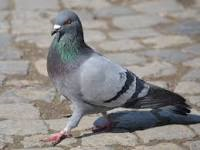

Sarah Roberts, Sustainable Projects Officer, University of Leicester emailed the Biodiversity Community of Practice network to ask,
“A subject has come up recently in our department about the most effective way to control the problem of pigeons. The development team have been working with us to try and find a method of keeping urban pigeons away from areas on certain buildings that are particularly difficult to maintain or important to be kept clean. Their faeces can be corrosive, unsightly and have the potential to cause respiratory problems – though catching an actual disease from them is unlikely.
This must be a fairly common problem for other universities and although every Environment Team may not have a close link with Estates, it does tie into the biodiversity aspect of our interaction with the natural environment.
Culling appears to be as ineffective as pigeon populations are dependent on a food source with the ability to breed all year round to keep flock numbers up. Little research seems to have been done on the long-term effects on control using falconry and perhaps only useful at certain events or areas in which no other deterrents are available.
One query is whether installing planted areas on roofs would provide a place for their faeces to break-down if the plant can cope with particularly acidic soils?
Please feel free to share any experiences, successes or innovations in this field that you know of and I’ll leave you with two websites which I have currently been looking at.
PiCAS UK: www.picasuk.com
Pigeon Control Resource Centre: www.pigeoncontrolresourcecentre.org “
EAUC Member Responses
Members can download the responses. You will need your EAUC log in to access this resource.







 Except where otherwise stated, content on this site is
licensed under a Creative Commons Attribution 3.0 License.
Except where otherwise stated, content on this site is
licensed under a Creative Commons Attribution 3.0 License.
